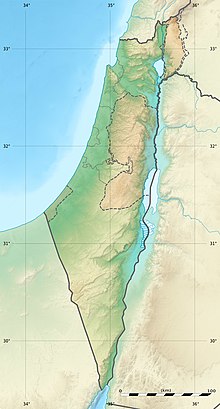
The Kingdom of Jerusalem, also known as the Latin Kingdom, was a Crusader state that was established in the Levant immediately after the First Crusade. It lasted for almost two hundred years, from the accession of Godfrey of Bouillon in 1099 until the siege of Acre in 1291. Its history is divided into two periods with a brief interruption in its existence, beginning with its collapse after the siege of Jerusalem in 1187 and its restoration after the Third Crusade in 1192.

Year 1187 (MCLXXXVII) was a common year starting on Thursday of the Julian calendar.
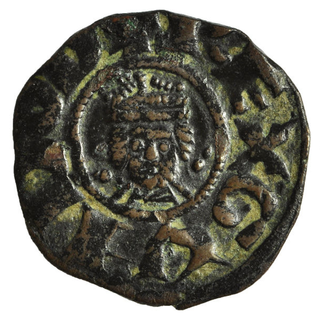
Guy of Lusignan was a French Poitevin knight who reigned as the king of Jerusalem from 1186 to 1192 by right of marriage to Sibylla, and King of Cyprus from 1192 to 1194.
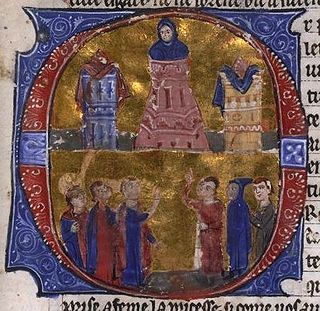
Raynald of Châtillon, also known as Reynald, Reginald, or Renaud, was a knight of French origin who became Prince of Antioch from 1153 to 1160 or 1161 and Lord of Oultrejordain from 1175 until his death. The second son of a French noble family, he joined the Second Crusade in 1147, and settled in the Kingdom of Jerusalem as a mercenary. Six years later, he married Constance, Princess of Antioch, in spite of her subjects' opposition.

The Battle of Hattin took place on 4 July 1187, between the Crusader states of the Levant and the forces of the Ayyubid sultan Saladin. It is also known as the Battle of the Horns of Hattin, due to the shape of the nearby extinct volcano of that name.
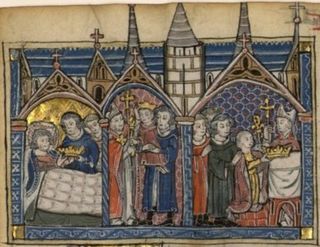
Raymond III was count of Tripoli from 1152 to 1187. He was a minor when Nizari Assassins murdered his father, Raymond II of Tripoli. Baldwin III of Jerusalem, who was staying in Tripoli, made Raymond's mother, Hodierna of Jerusalem, regent. Raymond spent the following years at the royal court in Jerusalem. He reached the age of majority in 1155, after which he participated in a series of military campaigns against Nur ad-Din, the Zengid ruler of Damascus. In 1161 he hired pirates to pillage the Byzantine coastline and islands to take vengeance on Byzantine emperor Manuel I Komnenos, who had refused to marry his sister Melisende. He was captured in the Battle of Harim by Nur ad-Din's troops on 10 August 1164, and imprisoned in Aleppo for almost ten years. During his captivity, Amalric I of Jerusalem administered the county of Tripoli on his behalf.

Bohemond III of Antioch, also known as Bohemond the Child or the Stammerer, was Prince of Antioch from 1163 to 1201. He was the elder son of Constance of Antioch and her first husband, Raymond of Poitiers. Bohemond ascended to the throne after the Antiochene noblemen dethroned his mother with the assistance of the lord of Armenian Cilicia, Thoros II. He fell into captivity in the Battle of Harim in 1164, but the victorious Nur ad-Din, atabeg of Aleppo released him to avoid coming into conflict with the Byzantine Empire. Bohemond went to Constantinople to pay homage to Manuel I Komnenos, who persuaded him to install a Greek Orthodox patriarch in Antioch. The Latin patriarch of Antioch, Aimery of Limoges, placed Antioch under interdict. Bohemond restored Aimery only after the Greek patriarch died during an earthquake in 1170.
Roger de Moulins was the eighth Grand Master of the Knights Hospitaller from 1177 until his death in 1187. He succeeded Jobert of Syria. His successors were two interim masters, William Borrel and then Armengol de Aspa, before the permanent Grand Master Garnier of Nablus was selected in 1190.

The Battle of Montgisard was fought between the Kingdom of Jerusalem and the Ayyubid Dynasty on 25 November 1177 at Montgisard, in the Levant between Ramla and Yibna. The 16-year-old Baldwin IV of Jerusalem, severely afflicted by leprosy, led outnumbered Christian forces against Saladin's troops in what became one of the most notable engagements of the Crusades. The Muslim Army was quickly routed and pursued for twelve miles. Saladin fled back to Cairo, reaching the city on 8 December, with only a tenth of his army. Muslim historians considered Saladin's defeat to be so severe that it was only redeemed by his victory ten years later at the Battle of Cresson, Battle of Hattin and the Siege of Jerusalem in 1187, although Saladin defeated Baldwin IV in the Battle of Marj Ayyun and the Siege of Jacob’s Ford in 1179, only to be defeated by Baldwin IV again at the Battle of Belvoir Castle in 1182 and the Siege of Kerak in 1183.

Gérard de Ridefort, also called Gerard de Ridefort, was Grand Master of the Knights Templar from the end of 1184 and until his death in 1189.
Heraclius or Eraclius, was archbishop of Caesarea and Latin Patriarch of Jerusalem.
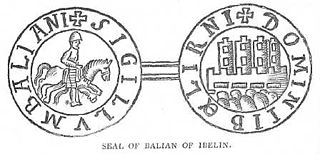
Balian of Ibelin, also known as Barisan the Younger, was a crusader noble of the Kingdom of Jerusalem in the 12th century. He was lord of Ibelin from 1170 to 1193. As the leader of the defense of the city during the siege of Jerusalem in 1187, he surrendered Jerusalem to Saladin on 2 October 1187.

The Siege of Jerusalem lasted from 20 September to 2 October 1187, when Balian of Ibelin surrendered the city to Saladin. Earlier that summer, Saladin had defeated the kingdom's army and conquered several cities. Balian was charged with organizing a defense. The city was full of refugees but had few soldiers. Despite this fact the defenders managed to repulse several attempts by Saladin's army to take the city by storm. Balian bargained with Saladin to buy safe passage for many, and the city was peacefully surrendered with limited bloodshed. Though Jerusalem fell, it was not the end of the Kingdom of Jerusalem, as the capital shifted first to Tyre and later to Acre after the Third Crusade. Latin Christians responded in 1189 by launching the Third Crusade led by Richard the Lionheart, Philip Augustus, and Frederick Barbarossa separately. In Jerusalem, Saladin restored Muslim holy sites and generally showed tolerance towards Christians; he allowed Orthodox and Eastern Christian pilgrims to visit the holy sites freely—though Frankish pilgrims were required to pay a fee for entry. The control of Christian affairs in the city was handed over to the patriarch of Constantinople.

Reginald Grenier was lord of Sidon and an important noble in the late-12th century Kingdom of Jerusalem.
Joscius was Archbishop of Tyre in the crusader Kingdom of Jerusalem in the late 12th century.

The Battle of Belvoir Castle, also called the Battle of Le Forbelet, was a Saladin’s campaign in May — August 1182 against the Crusader forces led by King Baldwin IV of Jerusalem battled with an Ayyubid forces from Egypt commanded by Saladin. The Crusaders successfully won and repelled Saladin's invasion effort. The theatre of operations included Ayla, Transjordan, Galilee and Beirut.
In the campaign and Battle of al-Fule, a Crusader force led by Guy of Lusignan skirmished with Saladin's Ayyubid army for more than a week in September and October 1183. The fighting ended on 6 October with Saladin being forced to withdraw.

The Battle of Marj Ayyun was a military confrontation fought at Marj Ayyoun near the Litani River in June 1179 between the Kingdom of Jerusalem under Baldwin IV and the Ayyubid armies under the leadership of Saladin. It ended in a decisive victory for the Muslims and is considered the first in the long series of Islamic victories under Saladin against the Christians. However, the Christian King, Baldwin IV of Jerusalem, who was crippled by leprosy, saved by his bodyguard and narrowly escaped capture during his escape.
Hugh II of Saint Omer was a Crusader knight and titular Prince of Galilee and Tiberias.
William Borrel was acting Grand Master of the Knights Hospitaller, ad interim, from 1 May 1187 until his death at the Battle of Hattin in 1187. He became custodian of the Hospitallers after the Grand Master Roger de Moulins was killed in the Battle of Cresson on 1 May 1187.

